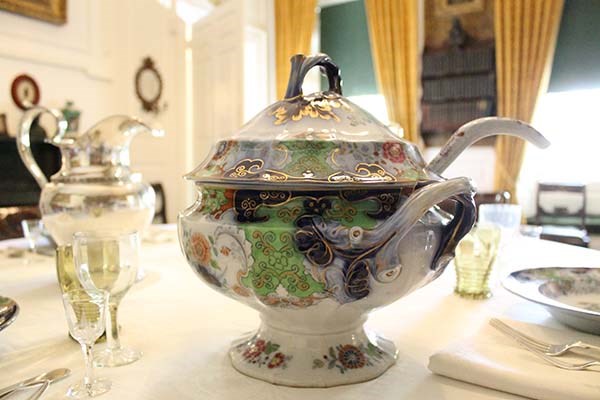

Left image
Right image
Colonial KitchenOriginally a kitchen for the Vassalls and for George Washington during his occupancy, this room looks dramatically different today than it did in 1759. Architectural examinations have found the foundations of a much larger fireplace complex for cooking. The small rooms on either side of the fireplace were probably open alcoves of the kitchen area. The wall opposite the fireplace was the original back wall of the house and would have had two windows, following the symmetry of the Georgian style. Some documents suggest the presence of a lean-to kitchen addition off this wall that pre-dated the 1790 ell extension. This room would have been a center of activity for the enslaved household staff of the Vassall family. At Headquarters, steward Timothy Austin oversaw the work of both hired and enslaved servants. Federal Dining RoomAndrew Craigie renovated this space in the 1790s to serve as his dining room during his large remodeling of the house. The kitchen was replaced by a new space in the service ell. A smaller fireplace replaced the original cooking fireplace and the Federal style paneling and delicate dentil molding were added at this time to decorate the room. The renovated dining room was connected to the formal parlor through a small ante-room to the right of the fireplace. 
NPS Photo Longfellow Dining RoomDistinguished GuestsThe dining room was a center of entertaining for many of the Longfellows’ notable guests. Charles Sumner was a regular guest at the table, with a standing invitation for Sunday dinners beginning in the 1840s. On 20 December 1849, the Longfellows hosted a dinner party in honor of Fredrika Bremer, a Swedish author and reformer. Henry Longfellow listed the nine guests in his journal and described the dinner:
In 1867, Charles Dickens joined the Longfellows for Thanksgiving dinner during the Boston leg of his second American tour. In his journal, his host noted only, "Thanksgiving Day. Dickens came out to a quiet family dinner at 2.30." Fourteen-year-old Edith Longfellow, somewhat more excited, told her cousin, "Thanksgiving day we had a rare treat, & Mr. Dickens came out to dinner!!!" Family DinnersWhen they were young, the Longfellow children usually ate in the nursery, but sometimes they were allowed to join their parents after dinner. In 1845 Sam Longfellow wrote, "Charley fat and quiet comes to table at dessert and sits up in his tall chair and pounds on the table with his little fists - while his papa makes the 'music of the spheres' for him on a finger glass..." The tall chair, given to Charley on his first birthday, had been Fanny Longfellow's as a child, and was probably used by the other children as well. As they grew older, the children regularly participated in family meals in the dining room. Letters and journals describe many lively meals with extended family and friends. The garden provided flowers for the table as Fanny described in a letter, "Tell Sam I found the garden in a very brilliant condition, the petunia bed especially, + was able to decorate my dinner table yesterday with a large bouquet, entirely home manufacture!" Letters and journals describe various foods served including oysters, partridge, venison, soups, pears, preserved peaches, figs, strawberries, pudding, pie, and special foods sent from friends abroad. The Longfellows drew upon their well-stocked wine cellar to accompany meals. After the children married, they often returned for Wednesday evening family meals. The Dante ClubThe dining room also played a central role in the early meetings of the Dante Club, a weekly gathering of Henry Longfellow's friends joining him for fellowship and assistance in his translation of the Divine Comedy in the 1860s. In Literary Friends and Acquaintance, William Dean Howells recalled:
The Portraits on the WallsThe dining room serves in part as a gallery of Longfellow and Appleton family portraits. On the north wall hang a pair of portraits of Fanny (Appleton) Longfellow's parents, Maria Theresa (Gold) Appleton and Nathan Appleton, painted in about 1806 by Gilbert Stuart. Between them hangs a portrait of their son, Thomas Gold Appleton, painted in Rome in 1845 by R.S. Lauder. Fanny Appleton and her sister Mary each appear in two portraits. A pair of oil on wood portraits by G.P.A. Healy depict the young women in 1834. A miniature double portrait depicts Mary in white and Fanny in black. The sisters sat for artist Jean Baptiste Isabey in France during their European Grand Tour of 1835-1837; the painting hung in the Louvre before it traveled to Boston. Over the doors to the left and right of the fireplace are crayon portraits by Eastman Johnson of Henry Longfellow's sisters, Mary Longfellow Greenleaf and Anne Longfellow Pierce, both done in 1846. Thomas Buchanan Read painted the Longfellows' three daughters, Edith, Alice, and Annie Allegra, in 1859. That same year, Longfellow described his daughters in "The Children's Hour," as "Grave Alice, and laughing Allegra / And Edith with golden hair." This portrait was later widely reproduced as the family became a part of their father's celebrity. A second portrait of Alice Longfellow, then mistress of the house, painted by her cousin Charles Hopkinson when she was about fifty years old, hangs on the other end of the wall. |
Last updated: February 2, 2022
